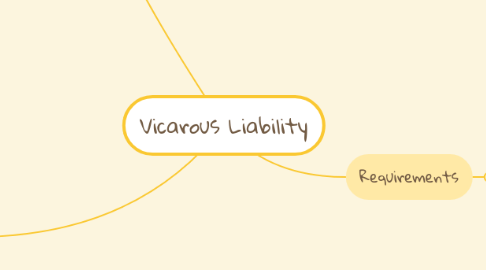
1. Definition
1.1. Employers are vicarously liable for the torts of their employees that are committed during the course of employment
2. Liability in respect of Independent Contractor
2.1. An independent contractor is a person who, although working for the employer, is not controlled by the employer in the method or conduct relating to the performance of that work
2.1.1. 1. Employer authorising the commission of a tort
2.1.2. 2. Torts which do not require intentional or negligent conduct by the tortfeasor
2.1.3. 3. Negligence of the employer
2.1.3.1. DBKL v ONG KOK PENG
2.1.4. 4. Non-delegable duties
2.1.4.1. DBKL v ONG KOK PENG
2.1.5. 5. Non-liability in respect of independent contractors
2.1.5.1. PADBURY v HOLIDAY & GREENWOOD
2.1.6. 6. Where third party is also an employee
2.1.7. 7. Where a claim is made in respect of one party only
2.1.7.1. LISTER v ROMFORD ICE AND COLD STORAGE LTD
2.1.8. 8. Liability in respect of agents
2.1.8.1. YEO TIN SANG v LIM CHOO KEE
2.1.9. 9. Employer's common law duty of care
2.1.9.1. MARNI BTE ANYIM v SHALINI SHANMUGAM
3. Requirements
3.1. 1. Wrongful or Tortious Act
3.1.1. The court will first determine whether a tort has been committed
3.2. 2. Special Relationship
3.2.1. Employer-employee relationship
3.2.1.1. Control test
3.2.1.1.1. Used to determine the nature of the relationship between the two parties
3.2.1.1.2. SHORT v J & W HENDERSON
3.2.1.2. Organisation test
3.2.1.2.1. Used to identify between a contract of service and a contract for service
3.2.1.2.2. STEVENSON, JORDAN AND HARRISON v MACDONALD AND EVANS
3.2.1.3. Multiple test
3.2.1.3.1. Based on common sense approach
3.2.1.3.2. READY MIXED CONCRETE (SOUTH EAST) v MINISTER OF PENSION AND NATIONAL INSURANCE
3.2.2. Grey areas
3.2.2.1. Hospital staff
3.2.2.1.1. A dissatisfaction associated with the control test is the vicarous liability of hospitals for the negligence of their staff
3.2.2.1.2. CASSIDY v MINISTRY OF HEALTH
3.2.2.1.3. TAN ENG SIEW v DR JAGJIT SINGH
3.2.2.2. Lending a worker
3.2.2.2.1. If B, who is the employee of A is lent to C and B subsequently commits a tort, the general principle is that A will be vicarously liable for the tort by B unless A has divested himself of all possession and control
3.2.2.2.2. MERSEY DOCKS AND HARBOUR BOARD v COGGINS AND GRIFFITHS (LIVERPOOL)
3.3. 3. Course of employment
3.3.1. An employer is only vicarously liable for the torts of his employee which occur in the course of employment
3.3.1.1. Term "course of employment" may differ
3.3.1.1.1. 1. Carelessness of worker in the performance of his job
3.3.1.1.2. 2. Unauthorised mode of doing something authorised or mistake of worker
3.3.1.1.3. 3. Tort committed in protection of employer's property
3.3.1.1.4. 4. Worker delegating his responsibility
3.3.1.1.5. 5. Worker acting for his own benefit
3.3.1.1.6. 6. Acting against employer's express prohibition
3.3.1.1.7. 7. Employee acting 'on a frolic of his own'
3.3.1.1.8. 8. Fraud of the worker
3.3.1.1.9. 9. Commission of theft by employee
3.3.1.1.10. 10. Sexual abuse by employee
3.3.1.1.11. 11. Vicarous liability for breach of statutory duty
3.3.1.1.12. 12. Time and its relevance in determining 'course of employment'
3.3.1.1.13. 13. Location or premises on which the injury occurs

